Visiting Egypt
On arriving in Cairo, and the usual airport cab hassles then the inability of the cab to find our hotel, a first priority was the Egyptian Museum and then a visit to Giza.
Cairo has a metro and a high priority was to try this out to avoid the, continuously lost, cabs as much as possible. It proved to be very good (£E1 = 20 Australian cents a trip) provided you can work it out for yourself. Asking for help was a formula for hostility, misunderstanding and/or misdirection. Men herd on and off the trains like bulls and signs like 'no exit' are completely ignored. There are separate 'women only' carriages. But on the train people are polite and often offered their seats and if you know what you are doing you are treated with efficiency and respect.
The metro is the best way to get close to the pyramids at Giza, just go to the Giza station and get a cab. While some desert is retained as a buffer zone, these are surrounded on three sides by the suburbs of Cairo.
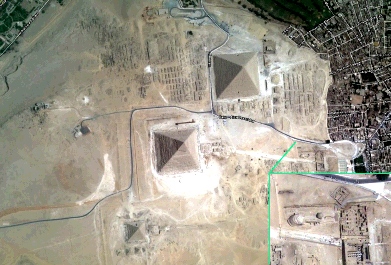
Giza Pyramids - enlarged sphinx in insert - Google Earth Photograph
Other metro stops get you to the ‘Opera’ on the Island in the Nile and the interesting Coptic Christian ghetto. Many pre-Constantine Christians fled to Egypt, particularly Alexandria to escape Roman persecution, so that the Coptic tradition in some ways precedes the establishment of the Roman church. The Church regards itself as the subject of many prophecies in the Old Testament. For example Isaiah Chapter 19, Verse 19 ‘In that day there will be an altar to the LORD in the midst of the land of Egypt, and a pillar to the LORD at its border.’ Because of the mutual Jewish roots in many ways the churches look more Islamic than Christian; but of course they precede Islam by 600 years.
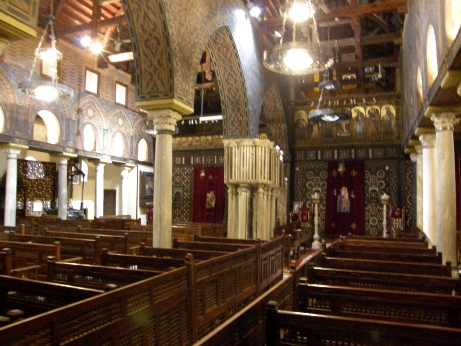
Coptic Church interior Cairo
After a couple of days in Cairo we took the train to Alexandria. This was interesting on several dimensions.
First was negotiating the touts at the Station in Cairo. We had the prescience to go the day before without any bags to buy return tickets. These had proven impossible to buy on-line; there is a facility but it seemed to be down. But in the event this was good because we took the metro to Murbarak where we were misdirected several times and accosted by one and all, before finding nearby Ramses station, which was behind scaffolding and a very dusty rubble-filled building site, and finally the ticket office. The next day with our bags, and then on our return, we negotiated it like locals.
The train runs through the Nile delta country and then westward along the coast to Alexandria. There was a vast array of crops under cultivation often in very small plots, including along the railway easement often up to the track (well fertilised). The predominant aid to human labour is the donkey. Agricultural machines are few and far between but wrecked cars were quite numerous. Everything looks desperately poor and the omnipresent rubbish piles were reminiscent of India, without the cows.
The train itself was something to behold. We had purchased first class tickets on the fastest express but externally the cars looked like anything but a quality express train. They were a dirty drab green and corroded; inside they were fine except that the outer pane of my double glazed window had a small hole and star crack in it as if it had been shot and was stained with rust. The cars were numbered in Arabic, the seats in Western numerals; another brief double-check required as 4 looks like a dyslexic 3. There are two stations in Alexandria and we got off too soon with most of the other passengers, requiring a long but interesting cab ride across the city. Despite our hotel being long established and prominent at the centre of the Corniche, again the cab driver could not find it (the old stop and ask technique). They always claim to understand where you want to go at the start of the trip.
The principal attraction in the city is the new and spectacular Library.
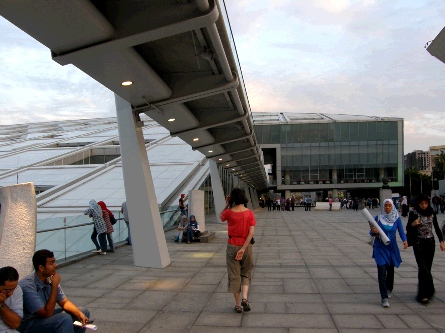
Library of Alexandria (Bibliotheca Alexandrina)
This commemorates the original famed ancient library of Alexandria, damaged by Julius Cesar and finally destroyed by the Christians, for its alleged pagan teaching and content, once Christianity became enshrined as the State religion. A bust of Alexander the Great stands in the forecourt.
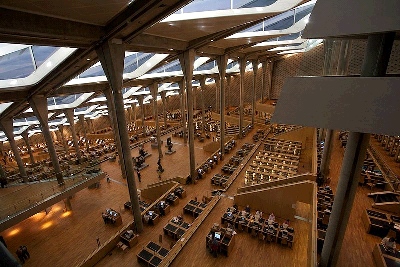
Bibliotheca Alexandrina Interior - web photo
The ancient Library was a seat of learning and education and its destruction is associated with the onset of the ‘dark ages’ of the common era. Some historians mark this point with the murder of ‘Hypatia of Alexandra’ in March 415. Hypatia was a famed female teacher; rationalist philosopher; mathematician; helio-centralist astronomer; experimental physicist and inventor of the hydrometer. The particularly brutal circumstances of her death have captured the imagination of many writers and artists since[6]. A recent movie ‘Agora’ dramatises these events.
Alexandria today is a wonderful example of a once prosperous and probably charming seaside resort town in tertiary decay. Among the redeeming features were the seaside restaurants; our hotel overlooking the square; the picturesque ancient trams; the small but good museum; the roman ruins including the small amphitheatre; and some quite nice, if run down, public gardens (not quite as nice as those in Broken Hill or Bathurst). But only someone fully up-to-date with their inoculations would enter the water.
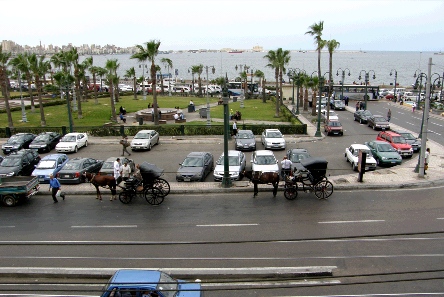
From Le Metropole Hotel Alexandria
From Cairo we flew to Luxor to pick up the Nile cruise. I’m going to skip over the next 24 hours as I intend to dine out on it. Suffice it to say if anyone is doing this you might want to talk to one of us first.
Luxor is built on the site of ancient Thebes and has the greatest array of ancient temples and associated ruins in Egypt. Together with Karnak nearby it is much more extensive and there is more to see than at Giza, most remains being around a thousand years more recent.
Tourism is the principal industry of Luxor, most being accommodated on dozens, perhaps hundreds of large, often palatial, river boats.
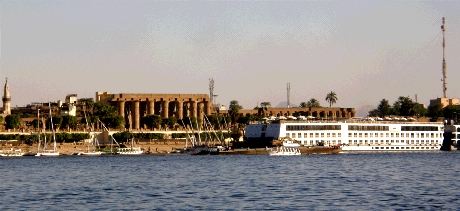
Luxor from the West Bank - the white objects are two river boats side-by-side
Major demolitions are presently in progress in order to uncover more of the ancient city, making the town very dusty and chaotic on the East bank. Ripping-off tourists is a major industry and we were told some tour groups are told not to go into town at all. Nevertheless bargaining for trinkets in the very extensive local markets was fun and good natured.
Across the river are the Valley of the Kings and Valley of the Queens as well as several large temples and tombs. The agriculture is predominantly sugar cane and the farmers seem very poor. We spent one night in a hotel on that side and caught the local ferry across (10 cents – less for locals).
Thebes was the capital of Egypt during the New Kingdom and glorifies the sun god Amon-Ra who was worshipped together with his wife, the Goddess Mut, and their son Khonsu, the God of the moon.
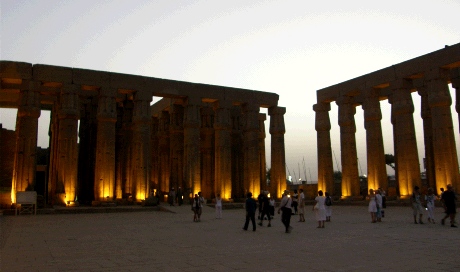
Luxor Temple
Thebes was attacked in 667 BCE by Assyrian emperor Assurbanipal who sacked it and left it in ruins, after which it fell in significance. But Alexander the Great was impressed by its temples and again raised its significance. Thebes is its Greek name. Later, during the Eastern Roman Empire, several of the temples were taken over by Christian monks. Their smoke has ruined the painting on some of the ceilings and they defaced a number of the images of Egyptian gods but not all. I thought this a mystery. Possibly parts were buried by sand or covered by wall hangings; or the task was unfinished; or they were objectionable in some areas only? Scaffolding and a considerable amount of time and effort would have been required.
In more recent times Napoleon’s troops used some features for target practice and European visitors carved their names and other graffiti into the walls.
Given our experiences to date in Egypt, the boat was more than we had expected. Our cabin was the size of a good hotel room with a large en suite, the claim that the ship was ‘five star’ was dubious but it was still very comfortable. We thought it excellent value as it included all meals, a guide, temple entrances connecting transport and several hours of rather pleasant felucca sailing near Aswan, where the Nile is particularly clean below the dams. Recommended.
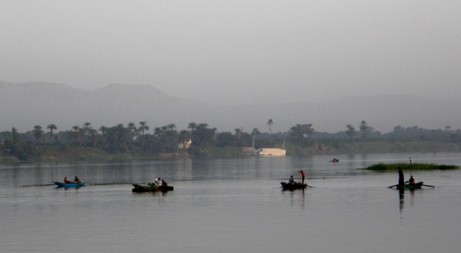
The Nile from our cabin in the morning
There was also entertainment. Although with only four English speakers, all Australian and all the other passengers Dutch, it was not directed to us nor was it very entertaining. There was a dervish and belly dancing show one night but we subsequently saw a much better show in Damascus.
The boat stopped at the principal ruins between Luxor and Aswan where we also paid a brief visit to the two dams, the old British dam and seven kilometres upstream the Aswan High earth-fill (rock and clay) dam built by the Russians.
In terms of volume of water volume this is the third largest reservoir in the world, and in engineering terms the eighth largest dam structure completed to date. Its main purpose is irrigation, increasing farmland 500% since 1970. The actual head (wall height) is relatively low and Electricity generation is consequently modest; it was built with a rated capacity of just 2.1 GW (twelve turbines, each alternator rated at 175 MW) but two units are not operating. Annual production is quite a bit less than Australia’s hydroelectricity generation (only 2.1% of our total). Compare this to the much smaller Three Gorges Dam in China that has a capacity of 18.2 GW and produces 80 TWh annually. New transmission infrastructure is very evident around Aswan and the upgrade, under a US aid programme appears to have included an increase in the output voltage, as well as the promised 10% improvement in turbine efficiency, partly to supply Egyptalum's nearby aluminium smelter at Nag Hammady. The equity of producing aluminium when a large proportion of the population have no electricity might be questioned.
Aswan itself is considerably up-market from the other Nile towns we visited, possibly with additional wealth generated maintaining the dam infrastructure, and of course, tourism.
